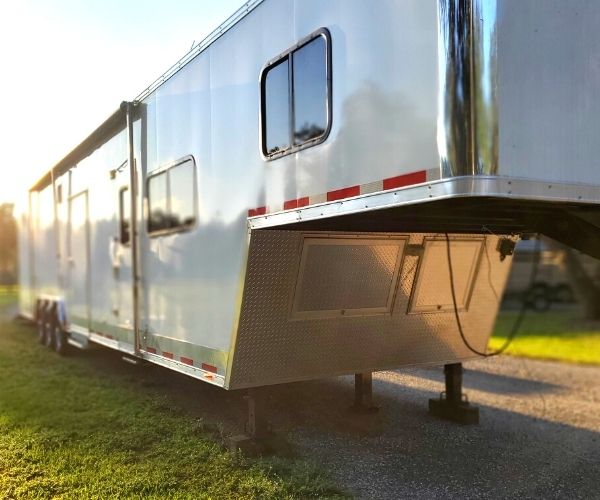This post contains affiliate links, meaning I get a commission if you decide to make a purchase through my links, at no extra cost to you. Please read my disclosure and privacy & terms for more info.
One of the top things that RV owners dread. Mice…
Despite RVers fears of the notorious poo-pyramid, tire blowouts, or becoming stuck— these furry and rather frustrating things can even be as bad as those two words RVers NEVER want to hear… Need a clue? It rhymes with “Shwater Shamage”…
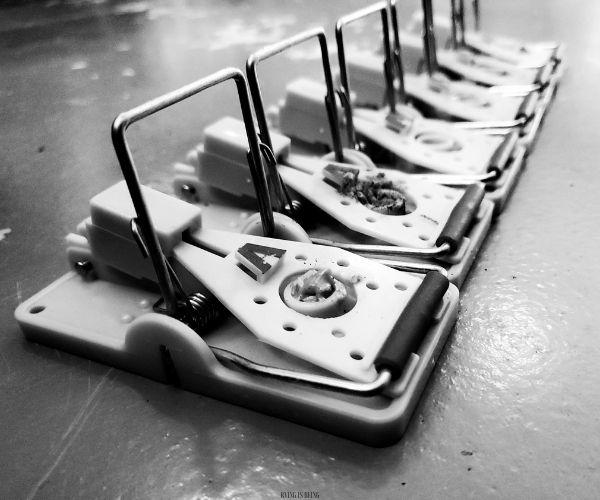
It’s not just their droppings or glimpse of a scurry across the floor that makes RVers shiver. As a matter of fact, it’s their immense destructiveness while also posing a serious health risk to you and your traveling family.
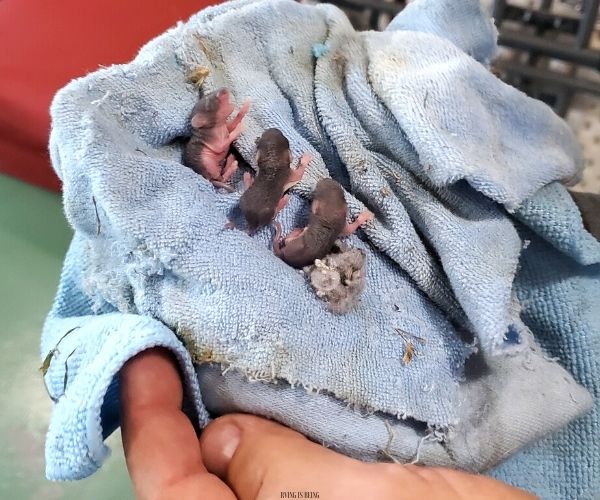
While mice can wreak havoc in campers, there’s preventative measures and different options you can use to help keep your RV free and clear of these pesky rodents.
How to Prevent & Get Rid of Mice in Your RV
Skip to:
Keep in mind…
There’s different methods of ridding homes and campers of mice, but one thing worth noting, is the risk of poisoning these guys.
As if mice are the last thing you want to deal with– DEAD MICE are the VERY LAST THING you ever want to deal with– in your camper… decomposing… in a wall, crevice, or cranny that you can’t get to to properly dispose of…
With that in mind, you may choose to consider a few other options of rodent control.
Prevent mice from moving in
Obviously, preventing mice from even accessing your camper in the first place is ideal.
This way you’re less likely to have to take further steps in getting rid of them and cleaning up after them– which can be even more expensive, time consuming, and aggravating.
Block them off
First, you’ll want to block every possible access point they can squeeze through.
RVs incorporate so many parts and pieces, moving mechanisms, and components capable of running from the outside in, powering and providing water to the unit. This in turn can create potential points of entry (around seals, slide-outs, wiring, and plumbing) for mice to squeeze through.
So, grab a headlight, an old rug to lay on, and do some stretches– because we’re going under!
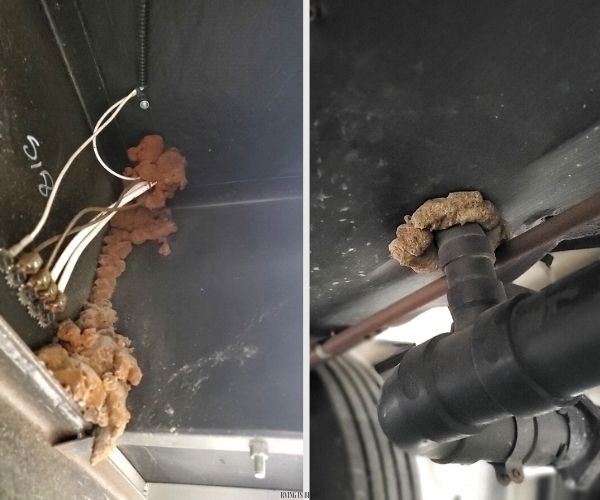
Look underneath the RV at the underbelly for any holes, gaps, and cracks indicating potential access points. Look around exposed plumbing and electrical cords going up into the unit. Use fill fabric or foam sealant to block off any openings where a mouse could squeeze through. Make sure to double check previous patchwork and touch up where needed.
Also, examine the cargo compartments, generator, battery compartment, and wet bay area.
Then, check the inside for holes and gaps. Look under sinks around plumbing, check the under-bed storage area, look in closets; pantry, kitchen cupboards, around the washer and dryer hookup, etc.
For motorhome owners, also check around the driver and passenger area for crevices or cracks a mouse could sneak in from. Remember, mice can get through the tiniest holes!
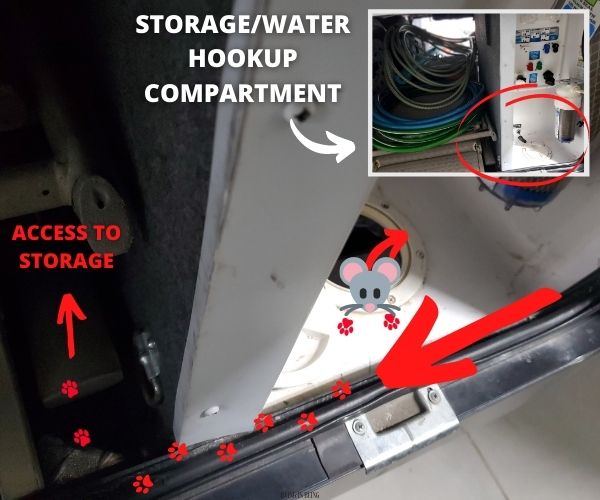
Above, is a storage and wet bay compartment on a Forest River fifth-wheel. From inside the wet bay, the water hose is thread through the bottom of the compartment and out to the campground water spigot. This design gives a mouse the chance to easily climb up the water hose and enter the wet bay compartment. This wouldn’t be the biggest deal if the wet bay was completely sealed-off from the rest of the RV. However, unfortunately (and quite shockingly) this wet bay does not completely close off from the cargo storage area–right next to it. In fact, there happens to be a 3/4 inch gap between the dual-compartment door and wall dividing these compartments– making the attached storage compartment easily breach-able for a mouse that has made it into the wet bay! From there, it can squeeze into the cargo where there’s loads of camping gear, warmth, and possibly further access points into the RV interior.
Keep in mind, finding the actual point of access can be downright impossible. With so many dime-sized gaps around plumbing, poorly sealed compartments, slide-out seals, and spaces around electrical cords, mice have a good chance squeezing through somewhere to gain access.
Clean, clean & clean
Many may leave this task for spring time when they are ready to bust the RV out of storage. However, you’ll want to spend some time deep cleaning your unit BEFORE putting it in storage.
Remember, you don’t want anything in the unit that could attract mice. A place with endless crumbs, bedding, and supplies at their little rodent fingertips makes it a place they’ll NEVER want to leave!
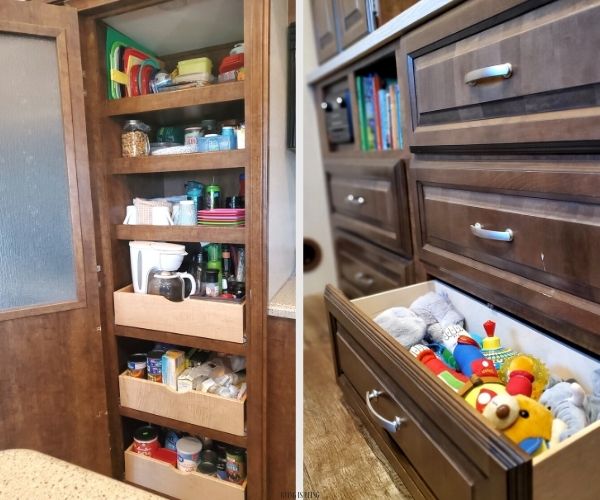
Do a thorough deep clean:
- Remove all food items.
- Remove trash.
- Wipe down cabinets, the pantry, and surfaces.
- Remove any valuables that could be chewed up and destroyed.
- Sweep or vacuum any leftover food crumbs (paying extra attention to under furniture, around slides, in cupboards and cabinets, and cargo areas.
- Store linens, toiletries, electronics, or non-perishables in heavy-duty, latchable bins. Especially cutlery, paper towels, napkins, or other picnic items that could be subject to mouse droppings or chewed up and used for their new nest.
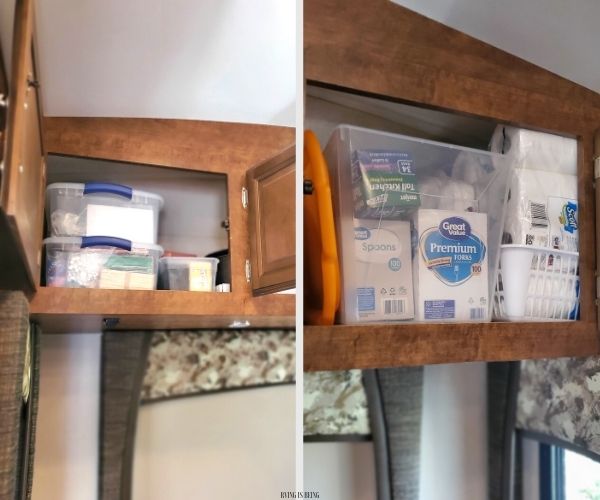
Park wisely
Unfortunately, many RVers can’t store their RVs inside a storage facility to help keep rodents away. It’s often slim pickings when it comes to parking and storing campers during the off-season. Obviously, if possible, a clean storage building significantly helps prevent mice.
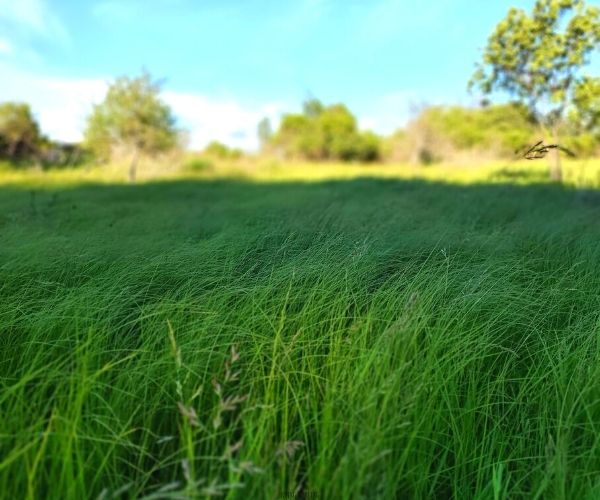
Aside from indoor RV storage, select a level surface– preferably on concrete and away from a wooded area or grassy field. Clean the location of any debris and keep the grass and weeds around the parked unit cut short.
Use Repellents Before They Move In
There’s a variety of different rodent repellents for different types of situations and owner’s preferences.
Mouse Repellents
Ultrasonic Repellent
These devices repel pests using ultrasonic waves that are irritating and disruptive to their environment. It is inaudible to humans and an environmentally friendly alternative to sprays or chemicals. There are battery-powered, 12V powered, or plug-in options.
Spray Repellent
Prevent mouse entry with non-toxic, no-mess, repellent spray. Use the handheld sprayer to thoroughly coat the RV undercarriage. This can be used for all types of RVs.
Try:
- Certified Earth Friendly Technologies Mouse Repelling Undercarriage Lubricant
- Exterminators Choice Vehicle Protection Rodent Defense Spray
- Tomcat Rodent Repellent Ready-To-Use
Repellent Fragrance Pouches & Products
Fresh Cab Botanical Rodent Repellent
Just place these ready-to-use, all natural rodent repellent pouches anywhere indoors where mice could be a problem. The aroma of balsam fir doesn’t affect pets or humans but drives rodents away. They are safe, effective and botanical.
With a long-lasting fragrance that mice can’t stand, mouse balls repel mice for up to 6 months. Twist and place where needed. Safe to use around kids and pets. The active ingredient is 100% pure and natural Appalachian peppermint oil.
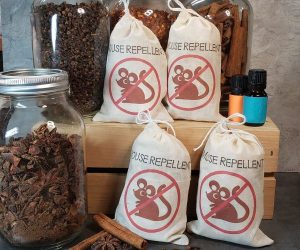
All Natural Mouse Repellent Pouches – Etsy
All Natural Mouse Repellent Pouches can be placed where mice may be a problem or where you’ve seen evidence of them. Made of all natural ingredients that repel mice, such as cloves, star anise, cinnamon, red pepper and essential oils including peppermint and citrus.
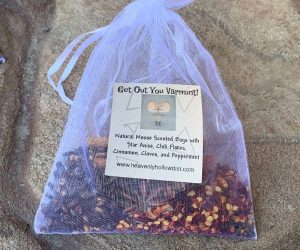
Get out Varmint Natural Mouse Repellent – Etsy
Place these potent anti-mouse bags of star anise, chili flakes, cinnamon, cloves, and peppermint- in cupboards, closets, in RV storage areas and more.
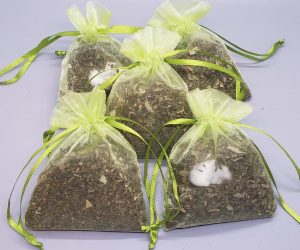
Stash these Repel-a-way bags where mice like to hang out. Features a blend of peppermint leaves, eucalyptus leaves, and a cotton ball with peppermint essential oil.
Many campers swear by Bounce Dryer Sheets warding off mice. Plus, they make your RV smell amazing!
Getting Rid of Mice
Past the point where rodents have already moved in?
Mice can move in and multiply fast. Without routinely checking your RV unit throughout winter, mice can be taking advantage of your pricey investment for WEEKS without you knowing.
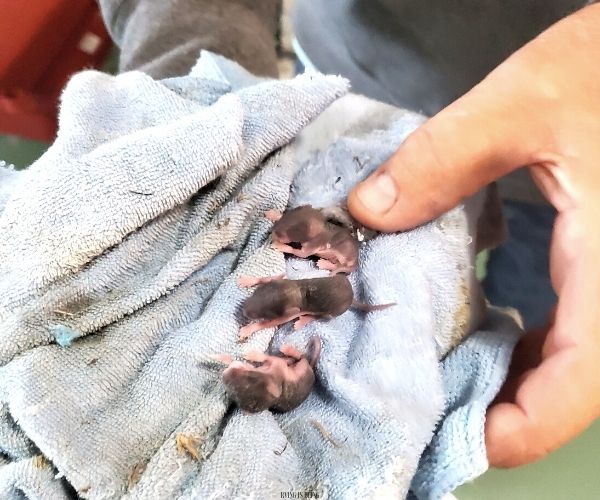
With that in mind, it’s extremely important to frequently check on your camper whether it’s sitting in storage, at a seasonal site, or parked in your yard for long periods of time.
Unfortunately, once evidence is found you must act fast! Mice can be extremely destructive, causing costly damage and posing serious health risks.
Mouse Removal & Traps
Just like repellant, there’s a variety of mouse traps and removal methods for your storage situation and/or personal preferences.
Mouse Traps
Catch Traps
Catch and release traps are simple to use, reusable, non-toxic, and safe for people and pets– being one of the safest and humane options of mouse removal.
Snap Traps
Traditional snap traps, like Tomcat or Victor Easy Set Mouse Traps are an easy, quick, and effective way of killing mice that can wreak havoc on RV units and belongings inside.
Electronic Traps
Another lethal option uses high-voltage shock to instantly kill mice. The Victor Electronic Mouse Trap delivers a quick shock and blinks to let you know when it’s time to empty the trap. The no see, no touch design makes this more favorable to have in RV cabinets while also being a safer option around children and pets.
Kick The Bucket Mouse Trap
With the ability to catch mouse after mouse, this low maintenance trap works indoors and outdoors all season long. Place near RV tires to catch mice before they enter your unit.
RinneTraps Flip ‘N Slide Mouse Trap
Made in the USA, this durable trap is both efficient and humane. The auto-resetting design makes it easy to use and maintain while continually trapping mouse after mouse. Snap the Flip ‘N Slide lid onto a standard 5-gallon bucket (not included) and setup is complete.
Tomcat Mouse Trap with Immediate Grip Glue
Tomcat Grip Glue is an effective way to stop a mouse right in its tracks. With immediate grip and hold, the professional-strength glue captures mice, ants, cockroaches, spiders and other pests. It comes ready to use right out of the box.
DoomBox Enclosed Mouse Trap
Designed using input from exterminators, DoomBox features an enclosed, strike-bar style mouse trap. Dual entrances make it so they can see a way out, coaxing them to come right in. The trap keeps the mouse and mess inside and can be reusable or disposable. It’s easy for adults to open but child resistant- keeping kids and pets out.
Keep in mind before considering bait stations or rat poison…
Not only can bait and poison be harmful to children and pets but can actually be more of a hassle to RV owners. As a matter of fact, bait or poison does not work immediately, causing rodents to ingest the substance and die shortly after. Between the time of eating the bait, rodents can crawl right back into their cozy location– in the RV sidewalls, motor, plumbing, or– basically somewhere impossible for humans to get the soon-to-be-corpse. Even if poison is placed outdoors around a parked unit, mice can still eat or carry the bait back inside the RV– and worse case scenario– back to the nest– leaving you with a decomposing family of mice somewhere in your RV that you can’t properly dispose of!
Remember:
- Never use poison at public or private campgrounds where other campers, people, and pets are present.
- Block off all potential access points from in and outside the RV.
- Keep your unit clean and remove food and trash. Store other belongings in tight-latching bins.
- Park the RV on a clean, concrete, or gravel area that is well-kept.
- Routinely check up on your RV unit and look for any signs of mice invasion (droppings, chew marks, nesting).
- Use repellent to ward off pests and prevent them from taking over your camper.
- Upon finding evidence of mice, act fast by placing removal devices and/or traps.
RVING IS BEING proactive and mouse-free
Related posts
Today's pick
Hot topics
Disclosure: This website contains affiliate links, meaning we will get a commission if you decide to make a purchase through the links, at no additional cost to you. Additionally, this website is an Amazon Associate. As an Amazon Associate, the owner of this website earns a commission as a result of certain qualifying purchases. CERTAIN CONTENT THAT APPEARS ON THE SITE TO WHICH THIS SITE LINKS ARE AFFILIATE LINKS. THIS LINKED CONTENT IS PROVIDED “AS IS” AND IS SUBJECT TO CHANGE OR REMOVAL ANY TIME. Please read this Site’s disclosure and privacy policy & terms for more information.
Categories
- Children & Family (15)
- Cookout Gear & Accessories (6)
- Food (2)
- Guide (37)
- Health (5)
- Holidays (10)
- List (10)
- Maintenance & Repair (10)
- Printables (4)
- Products & Accessories (40)
- Quote (3)
- RV & Campsite Setup (23)
- RVING (78)
- Shop Page (36)
- Storage & Organization (2)
- Tech (4)
- Travel (22)



